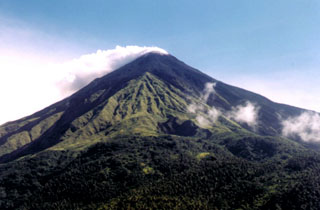Report on Karangetang (Indonesia) — 16 August-22 August 2023
Smithsonian Institution / US Geological Survey
Weekly Volcanic Activity Report, 16 August-22 August 2023
Managing Editor: Sally Sennert.
Please cite this report as:
Global Volcanism Program, 2023. Report on Karangetang (Indonesia) (Sennert, S, ed.). Weekly Volcanic Activity Report, 16 August-22 August 2023. Smithsonian Institution and US Geological Survey.
Karangetang
Indonesia
2.781°N, 125.407°E; summit elev. 1797 m
All times are local (unless otherwise noted)
PVMBG reported that dense white gas-and-steam plumes from Karangetang were visible daily rising as high as 200 m and drifting multiple directions during 16-22 August. Weather clouds sometimes prevented views of the summit. A webcam images published in the reports showed incandescence at the summit and from material on the flanks of Main Crater (S crater) on 17 August. Pyroclastic flows continued to be generated by collapsing material according to a 17 August new article. The Alert Level remained at 3 (on a scale of 1-4) and the public were advised to stay 2.5 km away from Main Crater with an extension to 3.5 km on the S and SE flanks.
Geological Summary. Karangetang (Api Siau) volcano lies at the northern end of the island of Siau, about 125 km NNE of the NE-most point of Sulawesi. The stratovolcano contains five summit craters along a N-S line. It is one of Indonesia's most active volcanoes, with more than 40 eruptions recorded since 1675 and many additional small eruptions that were not documented (Neumann van Padang, 1951). Twentieth-century eruptions have included frequent explosive activity sometimes accompanied by pyroclastic flows and lahars. Lava dome growth has occurred in the summit craters; collapse of lava flow fronts have produced pyroclastic flows.
Sources: Pusat Vulkanologi dan Mitigasi Bencana Geologi (PVMBG, also known as CVGHM), Antara News

